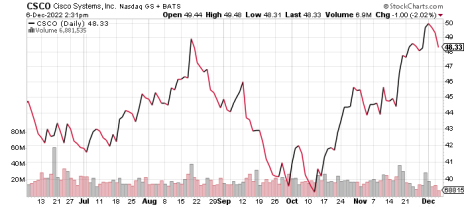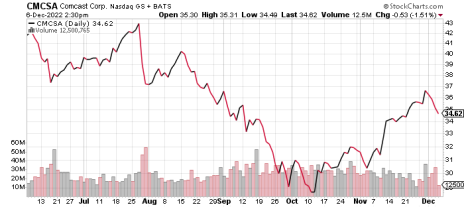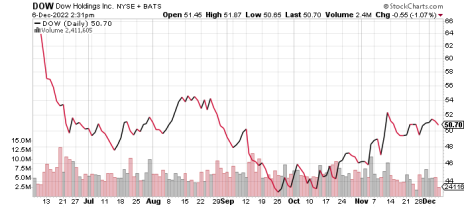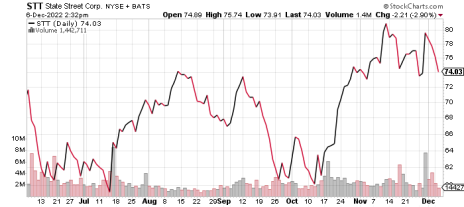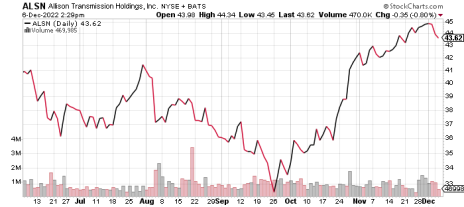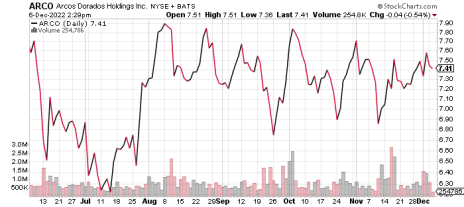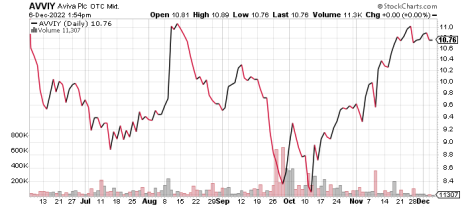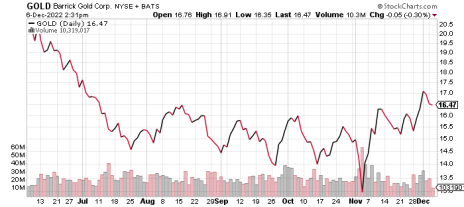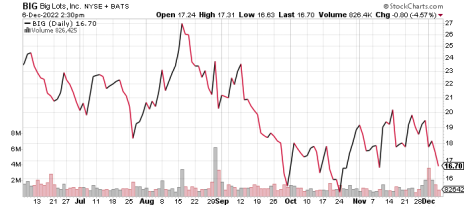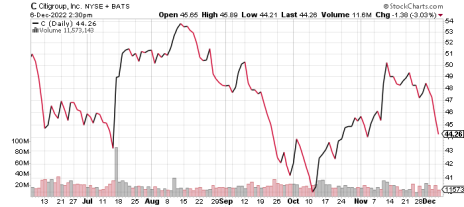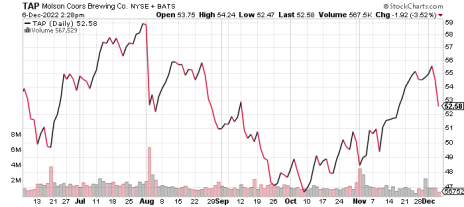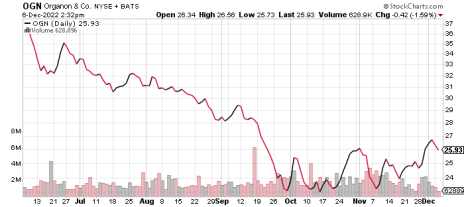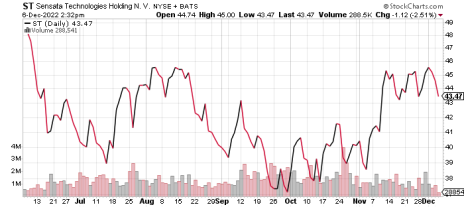Starting next week, you will receive your Cabot Undervalued Stocks Advisor issues and updates on Tuesdays instead of Wednesdays. So look for next week’s update in your email inbox a day earlier, on Tuesday, December 13.
Massive Inventory Cycle?
We’re not market or economic forecasters, but we do try to make sense of what is going on. And, as we’ve commented on in earlier notes, it seems more and more likely that what is going on in the economy is a huge inventory cycle. Things were mostly in balance prior to the pandemic … then we had a complete collapse in demand followed by a massive surge in demand in some industries (cars, houses and tech gear as notable examples) but not others (restaurants, travel and retailing). At the same time, we had a collapse in the supply of just about everything as factories closed and people stayed at home.
This shifted abruptly as the economy reopened and many supply-demand imbalances reversed. Supply chains got jammed up, Russia invaded Ukraine and the federal government dumped a few trillion dollars of free money into the economy. Industries across the economy were thrown out of balance, first in one direction, then the other. It is surprising that most companies navigated through all this as well as they did.
Picture a calm pond, then drop a boulder into it. Everything is jumbled, massive waves roll outward, and then the waves rebound off the shore and back to the impact site, waves crossing other waves. It’s chaos … but eventually it all calms down.
With supply coming back online, and demand waning, the shortages are turning into gluts. Retailers are stuck with massive unwanted inventory. Oil has dipped back below $75. Tech gear and semiconductors are in ample supply. Housing is slumping.
We think that, if our view is right, the economy should normalize by late 2023 or early 2024.
What makes this a challenge is that most professional investors have never seen a true inventory cycle. The last REAL inventory cycle was probably 40 years ago, if not longer. So, most investors think that we’re headed into a recession, perhaps one that is deep and dark.
A related mistake is that many investors use year-over-year comparisons, which can be misleading. For example, in October, existing housing sales fell 28.4% from a year ago – implying a collapse in housing demand. But, this comparison is against the very strong year-ago post-pandemic demand surge. When compared to the pre-pandemic average, October sales were down only about 16%. And this decline may mostly be under-demand that offsets over-demand during the pandemic period. Perhaps what we are seeing is a reversion toward normalcy.
So, we may see recessions that roll through some industries and then others, but not all industries at the same time. If we’re right, this is probably the time to jump on cheap but reasonably healthy cyclical companies like many of those on our recommended list.
Note on the Valuation and Earnings table:
We recently rolled our valuation and earnings estimate table forward by a year, dropping the 2022 estimates and adding the 2024 estimates. By this time of the year, stocks are starting to trade on estimated 2023 earnings, so our table now reflects these numbers.
Share prices in the table reflect Tuesday (December 6) closing prices. Please note that prices in the discussion below are based on mid-day December 6 prices.
Note to new subscribers: You can find additional color on past earnings reports and other news on recommended companies in prior editions and weekly updates of the Cabot Undervalued Stocks Advisor on the Cabot website.
Send questions and comments to Bruce@CabotWealth.com.
Today’s Portfolio Changes
Big Lots (BIG) – Reducing price target from 35 to 25.
Portfolio Changes Since Last Month
None.
Growth & Income Portfolio
Growth & Income Portfolio stocks are generally higher-quality, larger-cap companies that have fallen out of favor. They usually have some combination of attractive earnings growth and an above-average dividend yield. Risk levels tend to be relatively moderate, with reasonable debt levels and modest share valuations.
Growth/Income Portfolio | |||||||
| Stock (Symbol) | Date Added | Price Added | 12/6/22 | Capital Gain/Loss | Current Dividend Yield | Price Target | Rating |
| Cisco Systems (CSCO) | 11/18/20 | 41.32 | 48.4 | 17.10% | 5.80% | 66 | Buy |
| Comcast Corp (CMCSA) | 10/26/22 | 31.5 | 34.6 | 9.80% | 3.40% | 42 | Buy |
| Dow Inc (DOW) * | 4/1/19 | 53.5 | 50.69 | -5.30% | 5.50% | 60 | Buy |
| State Street Corp (STT) | 8/17/22 | 73.96 | 73.87 | -0.10% | 3.40% | 94 | Buy |
| Current price | 2023 EPS Estimate | 2024 EPS Estimate | Change in 2023 Estimate | Change in 2024 Estimate | P/E 2023 | P/E 2024 | |
| CSCO | 48.60 | 3.55 | 3.83 | 0.0% | 0.0% | 13.7 | 12.7 |
| CMCSA | 34.56 | 3.77 | 4.26 | -0.2% | -0.1% | 9.2 | 8.1 |
| DOW | 51.06 | 4.41 | 5.46 | 0.5% | 1.1% | 11.6 | 9.3 |
| STT | 74.52 | 8.24 | 9.37 | -0.8% | 0.9% | 9.0 | 8.0 |
Cisco Systems (CSCO) is facing revenue pressure as customers migrate to the cloud and thus need less of Cisco’s equipment and one-stop-shop services. Cisco’s prospects are starting to improve under a relatively new CEO, who is shifting Cisco toward a software and subscription model and is rolling out new products, helped by its strong reputation and entrenched position within its customers’ infrastructure. The company is highly profitable, generates vast cash flow (which it returns to shareholders through dividends and buybacks) and has a very strong balance sheet.
On November 16, Cisco reported a reasonably solid quarter. Results were ahead of the consensus estimates, and guidance for the next quarter and the full fiscal year were incrementally above current estimates. Cisco continues to generate prodigious amounts of cash flow, at $4 billion in the first quarter, up 16% from a year ago and reaching nearly 28% of revenues. Just over half of this $4 billion was spent on dividends and share buybacks – uses we find to be savvy given the shares’ depressed valuation. Cash net of debt increased to $10.7 billion. Valuation remains unchallenging as investors underestimate Cisco’s resilience. Please see our weekly note following the report for more detailed commentary.
Cisco was featured as Cabot’s Stock of the Week this week.
CSCO shares rose 1% for the week and have 36% upside to our 66 price target. The valuation is attractive at 9.5x EV/EBITDA and 13.7x earnings. The 3.1% dividend yield adds to the appeal of this stock. BUY
Comcast Corporation (CMCSA) – With $120 billion in revenues, Comcast is one of the world’s largest media and entertainment companies. Its properties include Comcast cable television, NBCUniversal (movie studios, theme parks, NBC, Telemundo and Peacock), and Sky media. The Roberts family holds a near-controlling stake in Comcast. Comcast shares have tumbled as worry about cyclical and secular declines in advertising revenues and a secular decline in cable subscriptions as consumers shift toward streaming services, as well as rising programming costs and incremental competitive pressure as phone companies upgrade their fiber networks.
However, Comcast is a well-run, solidly profitable and stable company that will likely continue to successfully fend off intense competition while increasing its revenues and profits, as it has for decades. The company generates immense free cash flow which is more than enough to support its reasonable debt level, pay a generous dividend (recently raised 8%) and sizeable share buybacks.
Comcast said that its Peacock streaming service has over 18 million paid subscribers, up from 15 million at the end of October. Separately, Comcast received a rating upgrade from longtime bear Wells Fargo Securities, which raised its rating to “equal weight” from “underweight.” The favorable shift was due to the analyst apparently over-estimating the negative effects of cord-cutting and other trends on Comcast.
Comcast shares slipped 3% for the past week and have about 22% upside to our 42 price target. The shares offer an attractive 3.1% dividend yield. BUY
Dow Inc. (DOW) is the world’s largest producer of ethylene and polyethylene, the most widely used plastics. Investors undervalue Dow’s hefty cash flows and sturdy balance sheet largely due to its uninspiring secular growth traits, its cyclicality and concern that management will squander its resources. The shares are driven by: 1) commodity plastics prices, which are often correlated with oil prices and global growth, along with competitors’ production volumes; 2) volume sold, largely driven by global economic conditions, and 3) ongoing efficiency improvements (a never-ending quest of all commodity companies). Recent concerns about a recession have send Dow shares to well-below our estimate of their fair value, even as the company’s long-term prospects and ability to maintain its dividend are attractive. Dow shares are a recommended Buy in our sister publication The Cabot Turnaround Letter.
There was no significant company-specific news in the past week.
Dow shares rose 1% in the past week and have 18% upside to our 60 price target (same as in the Cabot Turnaround Letter). The quarterly dividend appears readily sustainable and provides an appealing 5.5% yield. The shares trade at a modest 6.4x EV/EBITDA multiple and 11.6x EPS on recession-minded 2023 estimates. BUY
State Street Corporation (STT) – State Street is the world’s largest custodian bank, with $38 trillion in assets under custody/administration. About 56% of its revenues are produced from custody, client reporting, electronic trading and full enterprise solutions services for investment managers. The balance is produced from investment management fees on ETFs, foreign exchange fees, securities financing fees and net interest income. The industry has combined into four dominant firms due to economies of scale. State Street’s shares are out of favor and unchanged since 2007 due to concerns over its anemic growth and steady pricing pressure from competitors. However, we see State Street as a solid, well-capitalized franchise that provides critical services, with a slow-growth but steady revenue and earnings stream. Our interest in STT shares is that we can buy them at an attractive valuation. We also find the dividend yield appealing.
State Street terminated its long-delayed $3.5 billion deal to acquire the custody operations of asset manager Brown Brothers, citing on-going regulatory hurdles. The original deal would have been accretive to per-share earnings, but it appears that any deal acceptable to regulators would have erased any potential accretion and perhaps created other problems. State Street already raised about $1.9 billion of new equity at around $88/share to fund this deal – we would like to see the bank repurchase these shares at the current $74/share price. Analysts may trim their estimates as the hoped-for deal accretion won’t happen, but a prompt buy-back would offset much of this.
On the news, the shares jumped nearly 8%, suggesting that investors were relieved to have resolution of the overhang. State Street may pursue another deal elsewhere as the industry continues to consolidate – there probably are other pockets of captive custody assets like Brown Brothers that belong in either State Street’s hands or those of its three main competitors.
State Street shares rose 1% in the past week and have about 26% upside to our 94 price target. The company’s dividend (3.4% yield) is well supported and backed by management’s strong commitment. BUY
Buy Low Opportunities Portfolio
Buy Low Opportunities Portfolio stocks include a wide range of value opportunities, often with considerable upside. This group may include stocks across the quality and market cap spectrum, including those with relatively high levels of debt and a less-clear earnings outlook. The stocks may not pay a dividend. In all cases, the shares will trade at meaningful discounts to our estimate of fair value.
| Stock (Symbol) | Date Added | Price Added | 12/6/22 | Capital Gain/Loss | Current Dividend Yield | Price Target | Rating |
| Allison Transmission Hldgs (ALSN) | 2/22/22 | 39.99 | 43.63 | 9.10% | 1.90% | 48 | Buy |
| Arcos Dorados (ARCO) | 4/28/21 | 5.41 | 7.42 | 37.20% | 2.20% | 8.5 | Buy |
| Aviva (AVVIY) | 3/3/21 | 10.75 | 10.76 | 0.10% | 5.20% | 14 | Buy |
| Barrick Gold (GOLD) | 3/17/21 | 21.13 | 16.45 | -22.10% | 2.40% | 27 | Buy |
| BigLots (BIG) | 4/12/22 | 35.24 | 16.71 | -52.60% | 7.20% | 25 | Hold |
| Citigroup (C) | 11/23/21 | 68.1 | 44.21 | -35.10% | 4.60% | 85 | Buy |
| Gates Industrial Corp (GTES) | 8/31/22 | 10.71 | 10.92 | 2.00% | 0.00% | 14 | Buy |
| Molson Coors (TAP) | 8/5/20 | 36.53 | 52.59 | 44.00% | 2.90% | 69 | Buy |
| Organon (OGN) | 6/7/21 | 31.42 | 26.02 | -17.20% | 4.30% | 46 | Buy |
| Sensata Technologies (ST) | 2/17/21 | 58.57 | 43.5 | -25.70% | 1.00% | 75 | Buy |
Buy Low Opportunities Portfolio | |||||||
Current price | 2023 EPS Estimate | 2024 EPS Estimate | Change in 2023 Estimate | Change in 2024 Estimate | P/E 2023 | P/E 2023 | |
| ALSN | 43.61 | 5.89 | 6.56 | 0.7% | 0.0% | 7.4 | 6.6 |
| ARCO | 7.47 | 0.65 | 0.83 | 0.0% | 0.0% | 11.6 | 9.0 |
| AVVIY | 10.80 | 0.55 | 0.63 | 0.0% | 0.0% | 19.5 | 17.2 |
| GOLD | 16.49 | 0.77 | 0.96 | 1.3% | -5.1% | 21.5 | 17.2 |
| BIG | 16.76 | (0.45) | 2.89 | -164.3% | -28.5% | (37.2) | 5.8 |
| C | 44.61 | 6.78 | 7.51 | 0.0% | 0.0% | 6.6 | 5.9 |
| GTES | 11.01 | 1.17 | 1.31 | 0.0% | 0.0% | 9.4 | 8.4 |
| TAP | 53.09 | 4.12 | 4.37 | 0.0% | 0.0% | 12.9 | 12.1 |
| OGN | 25.97 | 4.84 | 5.31 | 0.0% | 0.0% | 5.4 | 4.9 |
| ST | 43.79 | 3.68 | 4.37 | 0.0% | 0.0% | 11.9 | 10.0 |
Current price is yesterday’s mid-day price.
Allison Transmission Holdings, Inc. (ALSN) – Allison Transmission is a midcap manufacturer of vehicle transmissions. While many investors view this company as a low-margin producer of car and light truck transmissions that is destined for obscurity in an electric vehicle world, Allison actually produces no car or light truck transmissions. Rather, it focuses on the school bus and Class 6-8 heavy-duty truck categories, where it holds an 80% market share. Its EBITDA margin is sharply higher than its competitors and on-par with many specialty manufacturers. And, it is a leading producer and innovator in electric axles which all electric trucks will require. The company generates considerable free cash flow and has a low-debt balance sheet. Its capable leadership team keeps its shareholders in mind, as the company has reduced its share count by 38% in the past five years.
There was no significant company-specific news in the past week.
The shares slipped 2% in the past week and have 10% upside to our 48 price target. The stock pays a respectable and sustainable 1.9% dividend yield. BUY
Arcos Dorados (ARCO), which is Spanish for “golden arches,” is the world’s largest independent McDonald’s franchisee. Based in stable Uruguay and listed on the NYSE, the company produces about 72% of its revenues in Brazil, Mexico, Argentina and Chile. At our recommendation date, the shares were depressed as investors worried about the pandemic, political/social unrest, inflation and currency devaluations. However, the company has a solid brand, high recurring demand, impressive leadership (including founder/chairman who owns a 38% stake) and successful experience in navigating local conditions, along with a solid balance sheet and free cash flow.
Macro issues have a sizeable impact on the shares’ trading, including local inflation and the Brazilian currency. Since early 2020, the currency has generally stabilized in the 1.00 real = $0.20 range – a remarkably favorable trait given the sharp declines in other currencies around the world. Recent weakness in the US dollar has not affected the US/Brazilian real exchange rate. As the company reports in US dollars, any strength in the local currency would help ARCO shares.
On November 16, Arcos reported an impressive third quarter that reflects the abilities of its strong leadership and brand to navigate the post-pandemic period. Revenues rose sharply (+38% in constant currency) even with high inflation/currency erosion in Argentina that dragged reported revenues down to +17%. Revenues were about 3% above estimates. Adjusted earnings of $0.23/share nearly doubled from $0.12 a year ago and were nearly double the consensus estimate of $0.12/share. Adjusted EBITDA of $103 million rose 15% from a year ago and was 13% above estimates. In local currency, Adjusted EBITDA rose 27% but were weighed down by higher food, paper, royalty fees and overhead costs. Please see our weekly note following the report for more detailed commentary.
There was no significant company-specific news in the past week.
ARCO shares rose 1% this past week and have 14% upside to our 8.50 price target. BUY
Aviva, plc (AVVIY), based in London, is a major European company specializing in life insurance, savings and investment management products. Amanda Blanc, hired as CEO in July 2020, is revitalizing Aviva’s core UK, Ireland and Canada operations following her divestiture of other global businesses. The company now has excess capital which it is returning to shareholders as likely hefty dividends following a sizeable share repurchase program. We expect that activist investor Cevian Capital, which holds a 5.2% stake, will keep pressuring the company to maintain shareholder-friendly actions.
On November 9, Aviva provided its third-quarter trading update, which included revenues, capital and dividends but not earnings. Overall, the company remains solidly capitalized, is producing strong operating performance and reiterated its dividend and buyback plans. Please see our weekly note following the report for more detailed commentary.
There was no significant company-specific news in the past week.
Based on management’s estimated dividend for 2023, the shares offer a generous 7.0% yield. Aviva shares were flat in the past week and have about 30% upside to our 14 price target. BUY
Barrick Gold (GOLD), based in Toronto, is one of the world’s largest and highest quality gold mining companies. About 50% of its production comes from North America, with the balance from Africa/Middle East (32%) and Latin America/Asia Pacific (18%). Barrick will continue to improve its operating performance (led by its highly capable CEO), generate strong free cash flow at current gold prices, and return much of that free cash flow to investors while making minor but sensible acquisitions. Also, Barrick shares offer optionality – if the unusual economic and fiscal conditions drive up the price of gold, Barrick’s shares will rise with it. Given their attractive valuation, the shares don’t need this second (optionality) point to work – it offers extra upside. Barrick’s balance sheet has nearly zero debt net of cash. Major risks include the possibility of a decline in gold prices, production problems at its mines, a major acquisition and/or an expropriation of one or more of its mines.
On November 3, Barrick reported a reasonable quarter but the company’s profits and cash flows are being incrementally squeezed by modestly lower gold prices, modestly weaker production volumes and higher costs. The company’s financial and operating condition remains strong but its underlying profitability is not as healthy as we had anticipated, even excluding the weaker gold price. We are staying with the Barrick position as it remains a well-managed company, is well-positioned to benefit from an eventual rebound in gold prices, has a solid balance sheet and pays a respectable base dividend that appears sustainable. Please see our weekly note following the report for more detailed commentary.
There was no significant company-specific news in the past week.
Over the past week, commodity gold rose 2% to $1,786/ounce. The 10-year Treasury yield slid to 3.59%. While investors had anticipated the “end-game” in which Treasuries peak at a roughly 5.0% yield (to roughly match or slightly exceed the anticipated inflation rate in a year or so), recent comments from Fed Chair Powell along with resilient labor demand may mean that rates peak above 5%. Similarly, we are seeing a few commentaries suggesting that the 2% inflation target isn’t sacrosanct, but that 3% or possibly even 4% inflation would be tolerable. If this tolerance takes hold, and the economy slows, the Fed’s inflation-fighting resolve may weaken and gold prices should rise. Investing in gold-related equities is a long-term decision – investors shouldn’t allow near-term weakness to deter their resolve.
The US Dollar Index, another driver of gold prices (the dollar and gold usually move in opposite directions), ticked down another 1% to 105.29.
Barrick shares rose 4% in the past week and have about 64% upside to our 27 price target. Our resolve with Barrick shares remains undaunted through the recent sell-off. BUY
Big Lots (BIG) – Big Lots is a discount general merchandise retailer based in Columbus, Ohio, with 1,431 stores across 47 states. Its stores offer an assortment of furniture, hard and soft home goods, apparel, electronics, food and consumables as well as seasonal merchandise. Our initial case for Big Lots rested with its loyal and growing base of 22 million rewards members, its appeal to bargain-seeking customers, the relatively stable (albeit low) cash operating profit margin, its positive free cash flow, debt-free balance sheet and low share valuation. Our thesis was deeply rattled by the company’s surprisingly large inventory glut in the first quarter 2022, likely burdening it with new and permanent debt.
On December 1, Big Lots reported a weak third quarter, as it worked down its inventory to about normal by discounting its merchandise but at the cost of posting a large loss. Looking ahead, the company is likely to return to a moderately subpar profit next year. But, we estimate that its inventory disaster, combined with the effects of higher freight costs and a slowing economy for its core customer base, will cost it about $460 million in permanent impairment of shareholder value. This is roughly $16/share in value. So, we are again trimming our price target to 25, compared to the prior 35 and the initial 45. Using approximate math, the 45 initial target less the 16 in value lost, plus a further $4 discount for the slowing economy and a loss of some of management’s credibility, gets us to our $25 target.
Where did the $16/share in lost value go? Assuming the company can recover to our initial operating assumptions, the $16 lost value went to debt holders, as this is roughly the new and permanent amount of debt ($460 million divided by the 29 million shares) on the company’s previously debt-free balance sheet. Big Lots will likely post break-even free cash flow in the fourth quarter, so we anticipate no seasonal debt paydown this year.
Why are we staying with this stock? We think the fundamental outlook is sufficiently depressed to provide a reasonable base to the share value, and that the shares are significantly undervalued relative to that base. And the shares are well positioned for a substantial new year bounce once the calendar turns. While this is perhaps a thin reed upon which to rest – and not strong enough to merit raising the rating to Buy – we think that investors are capitulating on Big Lots shares in front of the year-end and in fear of a recession.
Surprisingly, the company announced their $0.30/share quarterly dividend, but it appears they will rely on borrowing and some asset sales to fund the dividend in future quarters.
In the quarter, revenues fell 10% and the adjusted net loss of $(2.99)/share compared to a profit of $0.14 a year ago. Both were essentially in-line with the consensus estimates. The adjusted EBITDA loss of $(94) million compared to a $40 million profit a year ago and was 20% worse than the consensus estimate.
The discounting was seen in Big Lots’ gross margin, which fell nearly five percentage points from a year ago. We estimate that this decline was due both to lower volumes and lower prices. But, if inventory is truly in decent shape, with consumers in the mood for bargains (and with major retailers and producers looking to offload their glut at huge discounts to sellers like Big Lots), the company could have a reasonably normal-ish year in 2023.
Big Lots’ cost discipline is helping – admin costs rose only 3% in the quarter – even as inflation is probably raising their per-unit overhead costs at a 5-8% rate. Management is taking aggressive-enough actions, and provided reasonably conservative 4Q guidance which implies a break-even-EBITDA quarter, that we are incrementally encouraged that the wheels are not falling off. Liquidity and insolvency don’t appear to be issues given the company’s recently increased borrowing facility.
Big Lots shares remain high-risk due to the permanent debt balance and the likelihood of a suspension of the dividend.
Big Lots shares fell 13% this past week and have 49% upside to our revised 25 price target. The shares offer a 7.2% dividend yield, although, as noted, investors should not rely on this dividend being sustained.
We reiterate our view that Big Lots shareholders who are not willing or able to sustain further losses in the shares should sell now. There is no reasonably definable floor to a stock like Big Lots when fundamentals and valuation are ignored while investors reduce their risk exposure. HOLD
Citigroup (C) – Citi is one of the world’s largest banks, with over $2.4 trillion in assets. The bank’s weak compliance and risk-management culture led to Citi’s disastrous and humiliating experience in the 2009 global financial crisis, which required an enormous government bailout. The successor CEO, Michael Corbat, navigated the bank through the post-crisis period to a position of reasonable stability. Unfinished, though, is the project to restore Citi to a highly-profitable banking company, which is the task of new CEO Jane Fraser.
A new buyer for Citi’s Mexico retail operations has emerged after Grupo Financiero Inbursa dropped out of the bidding process. Grupo Mexico, a credible buyer, is said to be negotiating to buy the operations. We’re encouraged by the news and will celebrate when the check clears, as it were.
This past week, the yield spread between the 90-day T-bill and the 10-year Treasury bond, which approximates the drivers behind Citi’s net interest margin, widened to a negative 77 basis points (100 basis points in one percentage point), steepening the inversion of the yield curve over this horizon as 10-year yields fell while 90-day yields were largely unchanged. This spread is the widest since at least the early 1980s. Our interpretation is that investors are assuming that the Fed rate hikes and other macro drivers will drag down inflation to sub-5% or so in a year.
Citi shares trade at 55% of tangible book value and 6.6x estimated 2023 earnings. The remarkably low valuations assume an unrealistically dim future for Citi.
Citi shares fell 6% in the past week and have about 91% upside to our 85 price target. Citigroup investors enjoy a 4.6% dividend yield. We anticipate that the bank is done with share buybacks until there is more clarity on the economic and capital market outlook, which could readily be a year or more away. BUY
Gates Industrial Corp, plc (GTES) – Gates is a specialized producer of industrial drive belts and tubing. While this niche might sound unimpressive, Gates has become a leading global manufacturer by producing premium and innovative products. Its customers depend on heavy-duty vehicles, robots, production and warehouse machines and other equipment to operate without fail, so the belts and hydraulic tubing that power these must be exceptionally reliable. Few buyers would balk at a reasonable price premium on a small-priced part from Gates if it means their million-dollar equipment keeps running. Even in automobiles, which comprise roughly 43% of its revenues, Gates’ belts are nearly industry-standard for their reliability and value. Helping provide revenue stability, over 60% of its sales are for replacements. Gates is well-positioned to prosper in an electric vehicle world, as its average content per EV, which require water pumps and other thermal management components for the battery and inverters, is likely to be considerably higher than its average content per gas-powered vehicle.
The company produces wide EBITDA margins, has a reasonable debt balance and generates considerable free cash flow. The management is high-quality. In 2014, private equity firm Blackstone acquired Gates and significantly improved its product line-up and quality, operating efficiency, culture and financial performance. Gates completed its IPO in 2018, with Blackstone retaining a 63% stake today.
On November 4, Gates reported a reasonable quarter but reduced its full-year guidance as currency and supply chain headwinds aren’t relenting as fast as the company had hoped. The company continues to improve its execution and trim its cost structure. Its future looks bright once Gates passes through the currently choppy macro environment. Debt remains modestly elevated but this is not an issue given Gates’ management quality, business franchise and healthy-enough free cash flow. Please see our weekly note following the report for more detailed commentary.
There was no significant company-specific news in the past week.
At the current price and based on estimated 2022 results, the shares offer a 12% free cash flow yield (free cash flow divided by market cap). This is a sizeable discount to what the company is worth. GTES shares fell 3% in the past week and have about 27% upside to our 14 price target. BUY
Molson Coors Beverage Company (TAP) is one of the world’s largest beverage companies, producing the highly recognized Coors, Molson, Miller and Blue Moon brands as well as numerous local, craft and specialty beers. About two-thirds of its revenues come from the United States, where it holds a 24% market share. Investors worry about Molson Coors’ lack of revenue growth due to its relatively limited offerings of fast-growing hard seltzers and other trendier beverages. Our thesis for this company is straight-forward – a reasonably stable company whose shares sell at an overly-discounted price. Its revenues are resilient, it produces generous cash flow and is reducing its debt. A new CEO is helping improve its operating efficiency and expand carefully into more growthier products. The company recently re-instated its dividend.
There was no significant company-specific news in the past week.
TAP shares slipped 3% in the past week and have about 30% upside to our 69 price target. The stock remains cheap, particularly on an EV/EBITDA basis, or enterprise value/cash operating profits, where it trades at 8.6x estimated 2023 results, still among the lowest valuations in the consumer staples group and below other brewing companies. BUY
Organon & Company (OGN), a spin-off from Merck, specializes in patented women’s healthcare products and biosimilars, and also has a portfolio of mostly off-patent treatments. It may eventually divest its Established Brands segment. The management and board appear capable as they work to boost internal growth augmented by modest-sized acquisitions. The company produces robust free cash flow, has modestly elevated debt and pays a reasonable dividend.
On November 3, the company reported a weak third quarter with flattish revenues but a narrower profit margin. While the results were ahead of estimates, they reflect a company that is seeing a slower erosion relative to expectations, but a company that is eroding nonetheless. Organon raised its EBITDA margin guidance for the full year but its other guidance remained largely unchanged. Organon’s net debt remains unchanged from the spin-off date and we are wondering why Organon’s financial team can’t manage to convert more profits into cash. Please see our weekly note following the report for more detailed commentary.
There was no significant company-specific news in the past week.
OGN shares bounced 4% in the past week and have about 77% upside to our 46 price target (using the same target as the Cabot Turnaround Letter). The shares offer an attractive 4.3% dividend yield. BUY
Sensata Technologies (ST) is a $3.8 billion (revenues) producer of nearly 47,000 highly engineered sensors used by automotive (60% of revenues), heavy vehicle, industrial and aerospace customers. About two-thirds of its revenues are generated outside of the United States, with China producing about 21%. Investors undervalue Sensata’s durable franchise. Its sensors are typically critical components that generally produce high profit margins. As the sensors’ reliability is vital to safely and performance, customers are reluctant to switch to another supplier that may have lower prices but also lower or unproven quality. Sensata has an arguably under-leveraged balance sheet and generates healthy free cash flow. The relatively new CEO will likely continue to expand the company’s growth potential through acquisitions. Electric vehicles are an opportunity as they expand Sensata’s reachable market.
There was no significant company-specific news in the past week.
ST shares were flat in the past week and have about 71% upside to our 75 price target. Our price target looks optimistic in light of the broad market sell-off, but we will keep it for now, even as it may take longer for the shares to reach it. BUY
The next Cabot Undervalued Stocks Advisor issue will be published on January 3, 2022.

